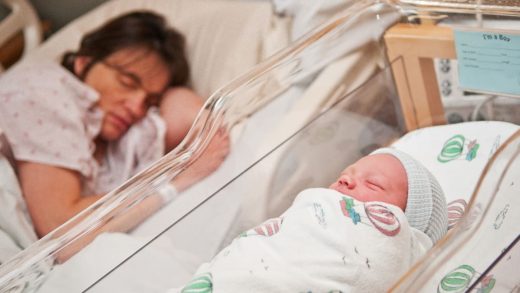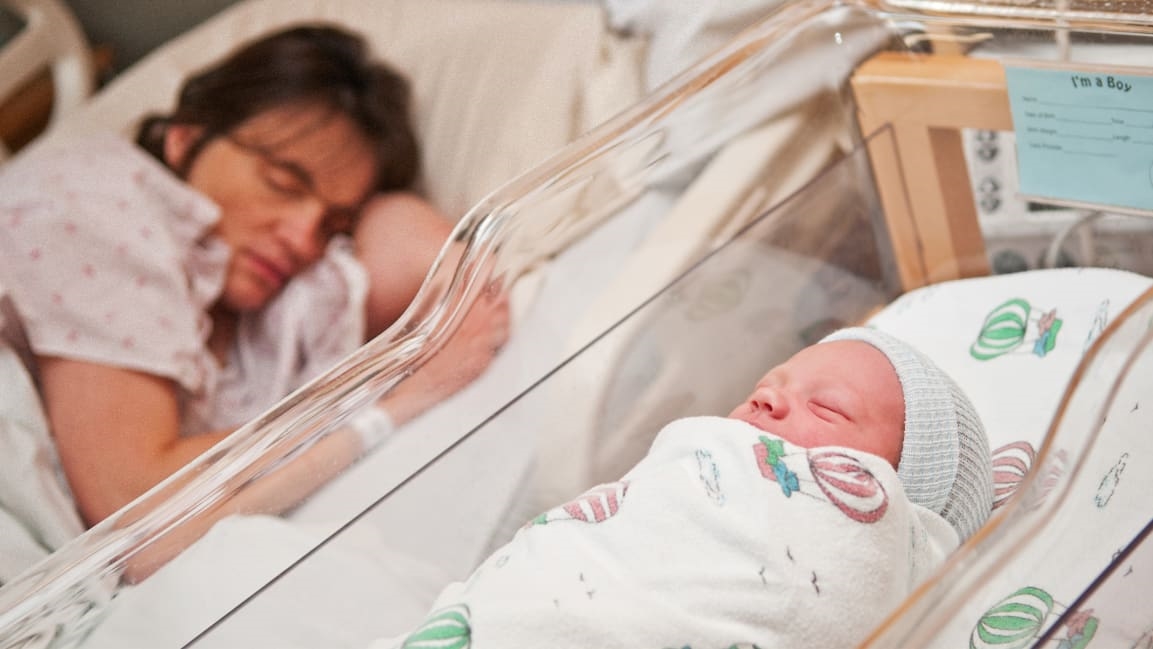Why parents are still clamoring for a safe co-sleeper
When I gave birth to my daughter four years ago, I was surprised by how swiftly she was taken away from me. Shortly after my C-section, the nurses took her out of the room, cleaned and swaddled her, and put her in a clear bassinet on wheels, which was placed next to the bed where I was recovering. That little crib would be her home for the next five days in the hospital. At night, they would not let her sleep in my bed, insisting it risked her safety, so she slept in that little box. I had carried Ella in my own body for nine months, feeling her heartbeat and her every movement. That she was suddenly away from me felt like a loss.
I felt helpless, but I also didn’t feel equipped to question it. After all, the American Academy of Pediatrics’ officially recommends that infants sleep on a separate surface from their parents, such as a crib or a bassinet, to “decrease the risk of sleep-related deaths.” This recommendation holds for the entire first year of a child’s life. According to the AAP, doctors worry that exhausted parents will crush their newborns by rolling onto them, or suffocate them by accidentally putting their hands on their tiny faces. The organization also makes frequent references to the statistic that 3,700 babies die every year from sudden infant death syndrome (SIDS) and accidental strangulation or suffocation in the United States. (A closer look at the data reveals that most of these cases involve parents who are drunk or have taken drugs, but more on that soon.)
When I read these figures as a new mother, they struck so much fear in me that I didn’t risk sleeping on the same bed as my daughter. At the same time, I had an overwhelming desire to be with her around the clock and cradle her as we both slept. It seemed totally unnatural to sleep away from her. After nine months in my womb, my daughter craved the comfort and warmth of my body, and I yearned for the opportunity to bond with her in those early days, when we were just getting to know one another. Research suggests that physical intimacy between parents and children, as well as direct skin-to-skin contact, has a host of physical and emotional benefits for newborns.
Would you like to see beds like this in all maternity hospitals? What a great help for c-section mammas too, but most of…
Posted by BellyBelly – Pregnancy, Birth & Parenting on Wednesday, June 3, 2015
I’m not the only mother who feels this way. Just this week, an image of a mother co-sleeping in a hospital with her baby went viral, with sites such as Parents.com, Motherly, and ScaryMommy picking it up. It’s not a new picture. An Australian parenting site called Belly Belly reposted an image from four years before on its Facebook feed. The photo was taken in a Dutch hospital called Gelderse Vallei, where mothers can opt for a co-sleeping device that clips onto the mother’s bed. The mother can go to sleep at night with her newborn right next to her, with plenty of space for both people and no worries that the infant will fall off the bed. It is, in fact, a very simple design: a modular half-moon-shaped bed that can be easily attached and removed.
When the image of the Dutch co-sleeping device first appeared online four years ago, parents across the world excitedly shared it and hoped that something similar would appear in their own countries. But four years later, nothing like this has yet become mainstream globally, which is perhaps why there is so much interest—and envy—bubbling up as people share the photo again. And for some doctors in the United States, even this hospital co-sleeper may not be safe enough. “The mother’s arm could go into that space in her sleep and cover the baby, or she could knock a pillow to the side and it’s on the baby,” one ob-gyn said on Yahoo Parenting when asked about this device.
Co-sleeping is a fraught issue, one that pits many parents against the medical establishment. This Dutch co-sleeper isn’t anything fancy. But the fact that it has gone viral (twice) reveals how desperate parents are for a solution.
Co-sleeping in the U.S. is more common than you think
The truth is that parents in the United States want to sleep with their children, and many, in fact, already do. Between 1993 and 2015, surveys show that co-sleeping spiked from 6% to 24%, despite doctors’ warnings. There are also many bedside sleeping devices on the market for home use that allow you to attach a bassinet to the side of your bed so you can sleep close to your child, though the American Academy of Pediatrics declines to comment on their safety. On its website, the AAP says it “cannot make a recommendation for or against the use of bedside sleepers or in-bed sleepers until more studies are done.”
Some doctors are pushing back on the AAP’s recommendations. They argue that the risks of infants dying because of co-sleeping are actually very low. Many of the studies about SIDS were conducted in the early 2000s and found that it often happens when parents sleep in the same bed as their children. But when you take a closer look at the data, the cases of sleep-related infant deaths mostly fell under a few categories: They involve parents who drink or do drugs, they involve premature babies or parents who smoke, and they involve babies sleeping on sofas with their parents and then getting trapped in the cushions.
According to NPR, which published a comprehensive article about co-sleeping in 2018, doctors and statisticians have recently reanalyzed the data to assess what the risk would be without any of these factors; two studies found that the risk of a child dying from c0-sleeping is very low. According to one pediatrician that reporter Michaeleen Doucleff interviewed, a parent who doesn’t drink, do drugs, or smoke and has a healthy baby will only increase the risk of sleep-related death by 0.004 percentage points by co-sleeping with his or her child.
If the real dangers of co-sleeping are so low, why is the medical establishment in the United States so adamant about making sure that parents don’t sleep with their children? Doucleff makes the case that there is a deep-seated cultural and historical resistance to co-sleeping that may inform how American doctors think of the practice. In the Western world, the idea of separating children from parents seems to go back to the Roman Empire, when rocking cradles and bassinets were a sign of wealth and status, so it was poor people who tended to co-sleep with their infants. Then, in the 10th century, the Catholic Church forbade parents to sleep in the same bed as their children. Doucleff suggests that this may have been driven by classism and the belief that the poor were inherently worse parents. The rules were designed “to prevent poor women from intentionally suffocating an infant whom they didn’t have resources to care for,” writes Doucleff. By 1576, the Church went so far as to excommunicate women who slept with their infants.
Co-sleeping around the world
This Western approach is very different from many other parts of the world, where c0-sleeping is the norm, and, in fact, the notion of separating parents and children seems cruel. Anthropologists have identified co-sleeping in 40% of all documented cultures, particularly in Asia, Africa, and South America. My own ancestors, in China and India, slept in the same bed as their children, often until they were several years old, according to historians. In these countries, co-sleeping continues to be widely practiced, and there is no evidence that it increases SIDS. But the design of the co-sleeping arrangements in these countries also matters. In many of these countries, which are tropical, there are few pillows and blankets that might suffocate or smother the child. This might partly explain why co-sleeping is safer in these countries.
In New Zealand and the United Kingdom, pediatricians have loosened their stance on co-sleeping. There, doctors personalize the risk of co-sleeping based on the parents’ characteristics and the health of the child. And this has, in fact, led to a significant decrease in sudden infant death. This may be because parents feel they can talk openly about their desire to co-sleep. In cases where doctors feel it would be too risky, such as if the parent has a history of alcoholism, they articulate the risk clearly, which might help those parents avoid SIDS.
Given how many parents want to co-sleep with their infants, and how safe the practice is for parents who don’t drink, do drugs, or smoke, isn’t it time that American doctors make co-sleeping an option?
Which brings us back to the co-sleeper at Gelderse Vallei. Shouldn’t hospitals work with designers to create a version of the device, and make it standard issue in neonatal wards, given the benefits of skin-to-skin contact as soon as the baby is born?
Equipped with the latest pediatric research, designers could create a device that is safe, easy to use, and encourages bonding between parents and children. To get such a project off the ground, pediatricians in this country would need to radically rethink their approach to co-sleeping and be open to collaborating with parents and designers to find solutions.
It’s been four years since the Belly Belly image first went viral, and parents around the world are still waiting for hospitals to install co-sleepers. Hopefully we won’t have to wait another four years for the AAP to get the message.
Fast Company , Read Full Story
(37)



